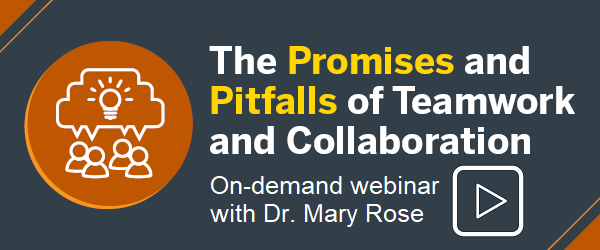
When is it best to tackle a problem or project with a group? Does working alone lead to greater creativity? What are the benefits and downsides to either option? We explore these questions and more in our latest on-demand webinar, The Promises and Pitfalls of Teamwork and Collaboration.
Dr. Mary Rose, Director of the Human Dimensions of Organizations program and Professor of Sociology at UT Austin, shares insights from social psychologists and real-world examples for how participating in groups can negatively and positively affect work. For this dialogue, we are talking about teams at a workplace that come together to solve a problem.
Social facilitation versus social inhibition
We enter the conversation asking the question, does the presence of others lead to individuals working harder and faster, or does being around others make people panic, choke, or become more inhibited? Whereas certain research shows examples of competition and presence of others to be beneficial when tackling physical tasks, most detail that individuals cannot participate in the way they want nor are they as motivated to participate when in a group dynamic.
This is especially true when it comes to brainstorming, a commonly used practice of teams within organizations. There are two primary reasons this rings true. One has to do with coordination and the other with motivation. In a group setting, taking turns sharing can interrupt a person’s creativity and listening to other’s comments can be too distracting. As individuals wait for their turn to speak, they are often rehearsing their own answer, completely missing the ideas being presented and the opportunity to build on those ideas, which is the main benefit of the exercise.
The other challenge of team settings which most of us are familiar with is what social psychologists’ term social loafing—when individuals either consciously or unconsciously decide not to participate. We see this when someone doesn’t trust the group or may be unclear as to whether their contribution will be valuable, so they remain silent or avoid engaging. Either way, this ducking of responsibility negatively impacts the group effort, requiring others to resentfully shoulder the load.
But teamwork isn’t going away
So how can we productively and positively engage with our co-workers to solve real problems? One way to combat social loafing is to put a practice in place where everyone’s voice is heard. That doesn’t mean everyone has to bring a new idea to the group, but they can weigh in on topics and conversations. That kind of participation also ensures different perspectives are shared and thoughtfully considered in each scenario.
Picking up on the theme of integrating varying opinions, practicing dissent in the group can also fuel the right kind of cohesiveness. Even on a good day, groupthink has the potential to sidetrack any project, and, on its worst, can lead to major catastrophes. Recalling the Bay of Pigs incident, in the committee room, no one questioned the plan, shared their reservations, or offered an opposing outcome. Any of these expressions could have meant an avoidance of this political fiasco. It is valuable to have someone in the room who is willing to play the role of the critic and ensure that conformity doesn’t sabotage the desired goal.
Key takeaways and reflective questions
When thinking about team best practices, it is important to note that diversity of opinions creates better decisions even when there is tension, and more equality in participation is correlated with better decision-making. Ensure your teams include individuals who can offer multipe perspectives and that there is a structure in place for those perspectives to be heard.
Some questions to ask yourself or your team when determining how to engage in a project or decision…
Are teams always the right approach for a task? What does the task require?
What systems of accountability are in place for the team? How will people know and trust that their own contributions matter for the task and for their success?
How is leadership supporting the team, particularly in managing dissent and encouraging a sense of healthy cohesiveness?
This dialogue is one example of how HDO engages their students to address organizational challenges. They begin with a core idea from social sciences and provide people with tools to recognize and reason varying issues within a team, department, or company. Listen to all the research, stories, and rationale from the webinar as well as extended Q&A to better understand how and when to use teams to solve problems and make decisions in your organization.

